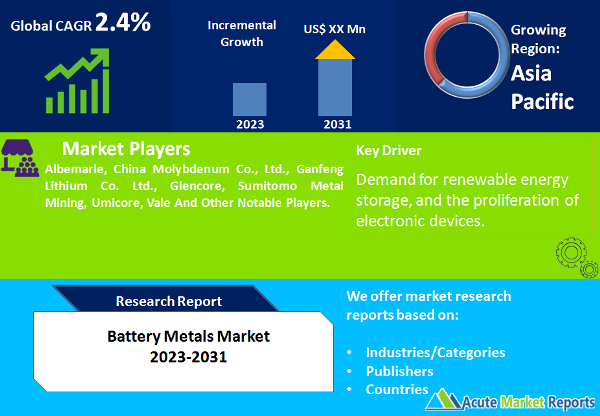
The battery metals market is expected to grow at a CAGR of 2.4% during the forecast period of 2024 to 2032. As the world continues its transition toward cleaner and more sustainable energy sources, the demand for battery metals has surged. The battery metals market is poised for significant growth in the coming years, driven by the surge in electric vehicle adoption, the demand for renewable energy storage, and the proliferation of electronic devices. However, supply chain vulnerabilities pose a substantial challenge. Market segmentation reveals exciting opportunities, particularly in the Stationary Battery Energy Storage (BES) and Nickel segments. As the industry continues to evolve, competitive trends and geographic shifts will shape the landscape of the battery metals market in the forecast period from 2024 to 2032.

Growing Demand for Electric Vehicles (EVs)
The rapid adoption of electric vehicles is undeniably one of the most significant drivers propelling the battery metals market. In recent years, there has been a remarkable shift in consumer preferences toward eco-friendly transportation options. Leading automotive manufacturers like Tesla, Nissan, and Chevrolet have embraced this trend by producing a diverse range of electric vehicles. As a result, lithium-ion batteries, which rely heavily on metals like lithium, cobalt, and nickel, have become the backbone of the EV industry. According to the International Energy Agency (IEA), the global electric car stock surpassed 10 million in 2020, indicating a year-on-year increase of approximately 45%. This remarkable growth in the electric vehicle market directly correlates with the increased demand for battery metals.
Surging Demand for Renewable Energy Storage
Renewable energy sources, such as solar and wind power, are becoming increasingly prevalent in the global energy mix. However, these sources are intermittent by nature, requiring efficient energy storage solutions. Battery metals are essential for stationary battery energy storage (BES) systems, which store excess renewable energy for later use. The transition to a greener energy grid, combined with government incentives and policies favoring renewable energy, has created a substantial demand for battery metals in the BES sector. The Global Battery Energy Storage Market is expected to grow at a CAGR of over 20% from 2024 to 2032.
Proliferation of Electronic Devices
The widespread use of electronic devices, ranging from smartphones to laptops and wearable technology, continues to rise. Battery metals are integral to the production of high-performance batteries used in these devices. Moreover, advancements in consumer electronics, such as 5G technology, have further boosted the demand for energy-dense batteries. According to the Consumer Technology Association (CTA), the global consumer technology industry is expected to generate revenues of over $400 billion in 2023, with electronic devices accounting for a significant portion of this revenue.
Supply Chain Vulnerabilities
A critical restraint facing the battery metals market is the vulnerability of its supply chain. Many of the key metals, including cobalt and nickel, are often sourced from geopolitically unstable regions. Additionally, concerns related to ethical mining practices, particularly in the case of cobalt, have raised questions about the sustainability and ethics of metal extraction. Instances of supply disruptions due to geopolitical tensions or labor-related issues have occurred in recent years, impacting the availability and pricing of battery metals.
Application: Electric Vehicles (EVs) segment Dominates the Market
The battery metals market can be segmented based on its applications, which include Starter, Lighting, and Ignition (SLI), Electric Vehicles (EVs), Electronic Devices, Stationary Battery Energy Storage (BES), and Others. In 2023, the highest revenues were observed in the Electric Vehicles (EVs) segment, driven by the increasing popularity of electric cars. However, the Stationary Battery Energy Storage (BES) segment exhibited the highest CAGR during the forecast period of 2024 to 2032, as the demand for renewable energy storage solutions continues to grow.
Product: Nickel Segment Dominates the Market
Market segmentation by product includes Lithium, Cobalt, Nickel, and Others. In 2023, the highest revenues were generated from the lithium segment, reflecting its widespread use in batteries. However, the Nickel segment is projected to experience the highest CAGR from 2024 to 2032, primarily due to its increasing utilization of lithium-ion batteries.
APAC to Lead the Growth
The battery metals market exhibits diverse geographic trends. In terms of CAGR, regions with substantial investments in renewable energy projects, such as North America and Europe, are expected to lead. Conversely, regions with a well-established electric vehicle market, including Asia-Pacific, are projected to dominate in terms of revenue percentage. North America is a significant player in the battery metals market, primarily due to its growing investments in renewable energy projects. The region is witnessing a surge in utility-scale battery storage installations, driven by the need to store and manage energy generated from renewable sources like wind and solar. In the United States, states like California and Texas are at the forefront of these developments. As a result, North America is expected to exhibit a robust CAGR in the battery metals market from 2024 to 2032. The Asia-Pacific region, especially countries like China and Japan, plays a pivotal role in the battery metals market. China is the world's largest electric vehicle market, and its government has been actively promoting EV adoption through incentives and subsidies. This has led to a robust demand for battery metals, particularly lithium and nickel, which are essential components of lithium-ion batteries. Japan, on the other hand, is a leader in advanced battery technologies and is making substantial investments in research and development.
Market Competition to Intensify During the Growth
Several companies involved in the battery metals market are exploring vertical integration strategies. This includes mining companies investing in battery manufacturing facilities and electric vehicle manufacturers securing their battery supply chains. Tesla, for instance, has been actively working toward vertically integrating its battery production. With increased attention on ethical and sustainable sourcing of battery metals, many companies are focusing on responsible mining practices. They are actively seeking to minimize the environmental impact of mining operations, address social concerns, and ensure a transparent supply chain. These initiatives are not only driven by ethical considerations but also by consumer demand for environmentally conscious products. Companies are heavily investing in research and development to enhance battery performance. This includes efforts to increase energy density, improve charging times, and extend battery life. Advancements in battery technology remain a competitive advantage, and companies that innovate in this space are likely to dominate the market. To meet the growing demand for battery metals, companies are expanding their global footprint. They are securing mining operations in resource-rich regions and establishing partnerships with local governments and communities. This global approach helps ensure a stable supply of critical metals. Collaboration is becoming increasingly common in the battery metals market. Mining companies, battery manufacturers, and electric vehicle makers are forming partnerships to streamline the supply chain and reduce risks associated with metal procurement. These collaborations also facilitate knowledge sharing and innovation.
Historical & Forecast Period
This study report represents analysis of each segment from 2022 to 2032 considering 2023 as the base year. Compounded Annual Growth Rate (CAGR) for each of the respective segments estimated for the forecast period of 2024 to 2032.
The current report comprises of quantitative market estimations for each micro market for every geographical region and qualitative market analysis such as micro and macro environment analysis, market trends, competitive intelligence, segment analysis, porters five force model, top winning strategies, top investment markets, emerging trends and technological analysis, case studies, strategic conclusions and recommendations and other key market insights.
Research Methodology
The complete research study was conducted in three phases, namely: secondary research, primary research, and expert panel review. key data point that enables the estimation of Battery Metals market are as follows:
Market forecast was performed through proprietary software that analyzes various qualitative and quantitative factors. Growth rate and CAGR were estimated through intensive secondary and primary research. Data triangulation across various data points provides accuracy across various analyzed market segments in the report. Application of both top down and bottom-up approach for validation of market estimation assures logical, methodical and mathematical consistency of the quantitative data.
| ATTRIBUTE | DETAILS |
|---|---|
| Research Period | 2022-2032 |
| Base Year | 2023 |
| Forecast Period | 2024-2032 |
| Historical Year | 2022 |
| Unit | USD Million |
| Segmentation | |
Application
| |
Product
| |
|
Region Segment (2022-2032; US$ Million)
|
Key questions answered in this report